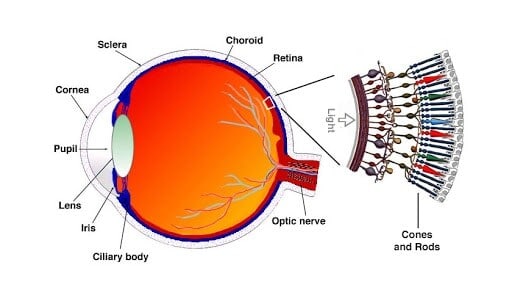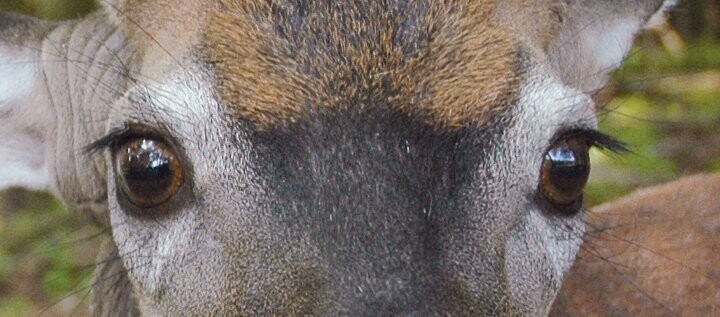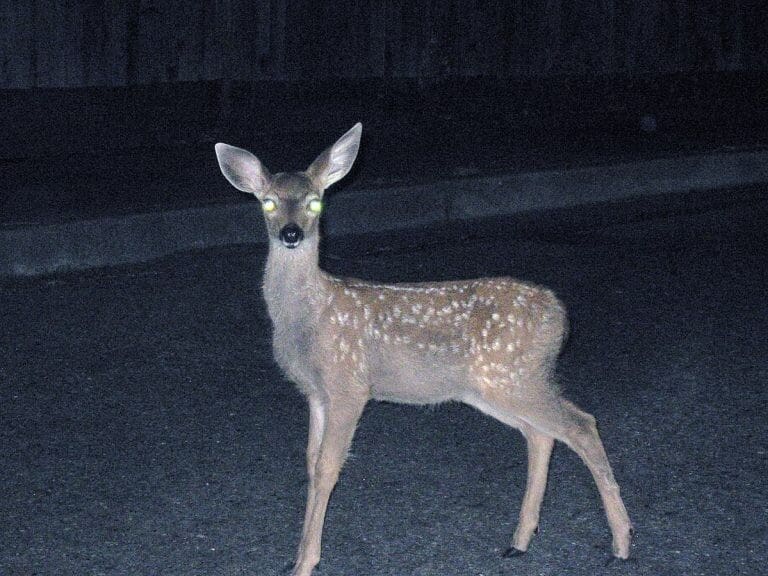For decades nocturnal bucks have given hunters a hard time. Of course, you can catch those bucks on camera midday during the summer, but as soon as the rut comes around, they are suddenly only active at night. So, if whitetail are able to turn nocturnal, that raises some questions. How well can deer see in the dark? How much better can they see than us? Can we use these facts to be more successful and become better hunters?
Whitetail deer can see in the “dark” but it is not dark to them. Their eyes are made in such a way so that they can detect what little light may be available and be able to see during most times of the day. So if there is enough moonlight, they can see perfectly fine at night. Whitetail deer do this by having perfectly suited eyes, along with a very specialized membrane in the back of their eyes called the tapetum lucidum.
Specialized Cells in the Eyes
The eye uses two types of specialized cells to interpret light, rods, and cones. The light is focused through multiple parts of the front of the eye, effectively acting as a lens. This focused beam of light then hits the rods and cones where it is interpreted and sent to the brain in the form of electric signals. The brain then makes those signals into our perceived reality.
Rods
Rods are responsible for interpreting light at low levels, known as scotopic vision. They are not capable of perceiving color. Whitetail have many more rods than we do. This is one of the major reasons that they can see in low light levels better than we can.
There is also another reason they see so well. They have a membrane in the back of their eyes that we do not. This membrane is called the tapetum lucidum and allows whitetail to reflect light through their eyes a second time. This effectively allows their millions of rods to look at the same light twice effectively doubling the amount of usable light available to them.

Cones
Cones are the cells responsible for perceiving light at higher levels, AKA daytime. This is known as photopic vision. These are also the cells that are responsible for perceiving color. Although whitetail cones are a tad different than ours. Humans are what we call trichromatic which means we see in the basic colors (red, green, blue). Whereas whitetails are dichromatic, so they can only see in two basic colors (green & blue).
This may be because their eyes focus more on interpreting low light levels instead of color. We know this because they have about 20 times more rods in their eyes than they do cones. Although there are plenty of studies and theories as to why this is the case, whether or not we can pin one reason as to why this is, is beyond me. We do know that this is the case and this is the reason we wear blaze orange. Orange is a shade of red, which deer cannot see.
How We Compare
The comparison between human and whitetail vision is a large one and honestly I could make an entire post about it. So here I will just go over the basics. We will talk about the general placement and construction of the eye, and the very important tapetum lucidum that we do not have.
General Construction
To start off, a whitetail’s eyes are placed on the side of their heads. This gives them around 300 degrees of sight, whereas humans have around 180 degrees of sight. This lets the deer be able to see more around them so they can be aware of approaching predators. However, this also limits their depth perception. Where you are able to look at something and know if it is 20 yards or 60 yards away, deer struggle to know exactly how far away something is. There is only about a 40-50 degree overlap between their eyes where depth perception is possible, but this still it is not as good as ours. What their eyes are good for is seeing movement. So, if they can see in the dark and see most of the movement, they are nearly capable of seeing everything.

Whitetail are able to see much better than we can in the dark. About 18 times better, but why? Whitetail deer have much larger eyes than we do and their pupils are about 3 times as large. Which effectively lets in 9 times as much light. So they already have 9 times more to work with than we do and then they get to use that light twice with the tapetum lucidum.
Double Reflection | The Tapetum Lucidum
When you shine a light in the eyes of an animal and see a red reflection (or what I used to call them as a kid “cigarette eyes”), what you are seeing is a reflection off the tapetum lucidum. This membrane in the back of a whitetails eye reflects light back through the eye so that they can process it twice. This effectively doubles the amount of usable light available to whitetail deer.

So if it is midnight and there is just a small amount of light being reflected off the moon, whitetail would not only be able to take in 9 times more light than us (because of their larger pupils) but they are also able to use that light twice, effectively seeing 18 times better than we do in the dark. Whitetails are not the only animals to have this though, many animals do. Things like, house cats, dogs, coyotes, and any nocturnal animal have a tapetum lucidum.
Benefits of Seeing Well in the Dark
For any prey animal, it is vitally important that they can see as well, if not better, than most predators during the night. Humans are the main predator of deer, with coyotes being second. So it becomes an advantage to deer to become nocturnal during the hunting season so that humans can not see them. Deer are not able to reason or comprehend that if they spend most of their time in the dark that humans will not hunt them. However, for those that do, they may live longer than other deer especially if they are large bucks.
It is also worth saying that if an animal can see well at night, in places where it is very hot during the day, they can wait until the cooler nights to move around and feed so that they do not use as many resources while going out to eat and socialize.
Overall, as a prey animal, it is vital to be able to use as many of their senses as possible at all times. If whitetail could not see in the dark at all, they would be easily picked off by predators at night. With their great eyesight, they are able to see movement during the day and night so that they can be alert and on defense at all times.
Deer Version During the Day vs Night
Most, if not all animals can see better in the daylight than the dark. More light leads to more information that can be processed. Whether deer are moving during the day or night, the most important thing for their vision is movement. Deer do not see details very well and according to research, their vision compares to ours at somewhere between 20/60 and 20/100. So what the average human sees at 100 yards, deer see at 20. So their vision is fairly blurry during night and day, although they do not need to see details to survive, they only need to see movement to know when a predator is close by.
Conclusion
Because of the well-suited construction of a whitetails eye, they can see in the dark very well. They have very large pupils and a high concentration of specialized cells in their eyes called rods that are used to interpret light at low levels. Not only are they able to pick up much more light than we are with their large eyes and higher number of rods, but they also get to interpret that light twice by reflecting it through a membrane in the back of their eyes called the tapetum lucidum. All of these factors combined, whitetail can see at least 18 times better in the dark than we can. All and all, unless it is a new moon, the odds are whitetail deer can see everything going on at night. Even when we cannot see our hands in front of our faces.
Thank you for reading my article about whitetail vision at night. I hope you enjoyed it and learned something you didn’t already know. If you like my content, subscribe to my weekly update. If you have any other questions about how well whitetail can see in the dark or just want to connect, feel free to email me at Patrick.Long@omegaoutdoors.net.
Sister Post | Can Whitetail See Orange?
A sister post is another post that I have written that follows along with the same topic as the one you just read. I think that following this post, my post about if whitetail can see the color orange will provide a lot of value and may teach you even more about deer and deer vision.
Does wearing orange effect you hunt? Ever since wearing red or blaze orange became law in 1986, and later mandatory blaze orange in 1994, hunters have questioned if their game could see it or if it has a negative impact on the hunt; however, whitetail and humans see colors differently and we use this fact to keep hunters protected from each other while also keeping them concealed in the woods… Keep Reading
Protanopia – Red/Green Color Blindness
Humans are trichromatic which means we can see all three primary colors: red, blue, and green. We can see all of these colors and the colors they make when they mix. Whitetail are…Keep Reading
What About the Research?
So how do we know for a fact that whitetails are dichromatic? Elizabeth Ashley Miller (University of Georgia) under the direction of Dr. Karl V. Miller, and Dr. Robert J. Warren carried out a research project to test the visual aptitudes of white-tailed deer. They used this apparatus to supply a stimulus to the whitetail and record the reaction to said stimuli… Keep Reading
